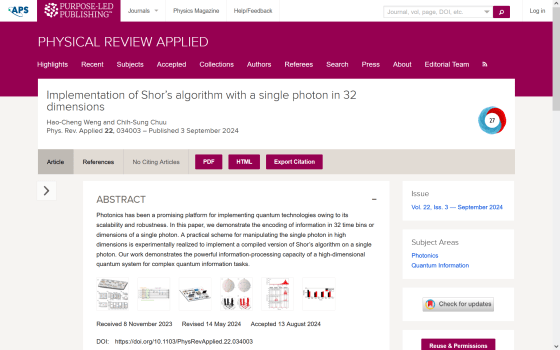Taiwanese research team develops desktop quantum computer

A research team from Tsinghua University has announced that it has developed the world's smallest quantum computer, which uses only a single photon. It is the size of a desktop PC and can operate at room temperature, and has been demonstrated to be able to perform complex mathematical operations such as prime factorization.
Phys. Rev. Applied 22, 034003 (2024) - Implementation of Shor's algorithm with a single photon in 32 dimensions

The world's smallest quantum computer that produces single photons for Tsinghua University [2024.10.16 Secretary's Office] - Top page story: National Tsinghua University
Scientists build the smallest quantum computer in the world — it works at room temperature and you can fit it on your desk | Live Science
https://www.livescience.com/technology/computing/scientists-build-the-smallest-quantum-computer-in-the-world-it-works-at-room-temperature-and-you-can-fit-it-on-your-desk
While state-of-the-art quantum computers generally operate in cryogenic environments, the quantum computer developed by Qisong Zhu of Tsinghua University operates at room temperature. The equipment is small enough to fit inside a box that a person can hold, and the researchers said, 'We sincerely hope that in the future, we will all have a single optical quantum computer on our desks!'
The quantum computer developed this time is a 'single-photon quantum computer' that uses only one photon, and according to Chu, 'one photon has 32-dimensional information space.' Some quantum computers handle hundreds of photons, but they are difficult to control. Chu continued his research from the perspective of 'compressing all information into one photon' with a reverse idea, and succeeded in developing a special quantum computer. It is said that this is the first time in the world that multidimensional photons, 32 dimensions, have been implemented in a quantum computer.

Generally, quantum computers that use electrons and ions require energy and development costs, but optical quantum computers that use photons are said to overcome these two dilemmas. In addition, photons have the advantage of being easy to transmit over long distances and are less susceptible to interference.
Chu likened the process of compressing all information into a single stable photon to 'turning a bicycle that can only carry one person into a 32-car train that can carry a huge number of passengers.' A single quantum computer can perform operations such as factorizing numbers such as 15=5x3, and the next step, Chu explained, is to 'continue to improve the memory capacity of single photons so that they can handle even more complex calculations.'

Dean of Tsinghua University's School of Science, Mo Chongyu, emphasized that 'this optical quantum computer is the result of independent research and development by the university's Quantum Technology Research Center, and demonstrates the university's innovative capabilities and technological strength in quantum technology.' He emphasized that optical quantum computer technology will have a wide range of applications in the future, including accelerating research and development of new drugs, optimizing logistics, and improving information security when combined with quantum communications.
Related Posts:
in Hardware, Posted by log1p_kr







